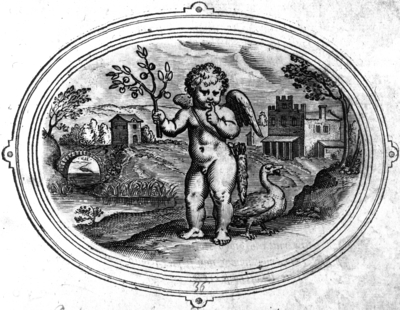Nocet esse locutum [36]

Translations
 |
Het doet verdriet te hebben gesproken [cf. Disticha Catonis 1, 12, 2] |
 |
It hurts to have spoken. [cf. Disticha Catonis 1, 12, 2] |
 |
Cupido verzegelt zijn lippen met zijn vingers en hij verbiedt iemand die niets wil verzwijgen om lief te hebben. |
 |
Cupid closes his lips with his fingers, he forbids someone to love who wants to have a talkative heart. |
 |
Ovidius, Ars amatoria 2, 607-608
Bovenal gebiedt Venus over haar rituelen te zwijgen; mijn advies is dat een loslippig iemand niet naar haar toegaat . |
 |
Ovidius, Ars amatoria 2, 607-608
Cytherea above all forbids her rites to be told of; I give warning that no talkative person approach them. [tr. J.H. Mozley,
Loeb, p. 107] |
Literature
- Henkel and Schöne, Emblemata
 , col. 833
, col. 833
- Praz, Seventeenth-Century Imagery
 , p. 107
, p. 107
- Extensive discussion of this emblem's functioning: Daly, Emblem Theory
 , pp. 102-107
, pp. 102-107
- Sebastiàn, Lectura crítica
 , p. 26
, p. 26
Sources and parallels
- Alciato, Book of Emblems
 , embl. 11
, embl. 11 -
Parallel for the pictura (mirrored) and the Latin, Italian and French motto in: Un Cupidon tenant une Branche en la Main, & comprimant sa Bouche avec son Doigt (in: Daniel de la Feuille, Devises et emblemes (1691))
[Compare
![Compare [compare]](/static/images/compare2.gif) ]
]
References, across this site, to this page:
- Un Cupidon tenant une Branche en la Main, & comprimant sa Bouche avec son Doigt (in: Daniel de la Feuille, Devises et emblemes (1691))
Iconclass
A cupid holds up the branch of a peach-tree while putting a finger on his lips; a goose with a stone in its beak- kinds of non-precious stone
[25D12]

- water-birds: goose
[25F36(GOOSE)]

- fruits: peach
[25G21(PEACH)]

- trees: peach-tree (+ branch, stick)
[25G3(PEACH-TREE)(+22)]

- brook
[25H212]

- farm or solitary house in landscape
[25I3]

- landscape with bridge, viaduct or aqueduct
[25I6]

- putting a finger to the lips, 'Silentium'; 'Silentio' (Ripa)
[31B623591]

- Taciturnity; 'Secretezza', 'Secretezza overo Taciturnité' (Ripa) (+ emblematical representation of concept)
[52DD3(+4)]

- (personifications and symbolic representations of) Love; 'Amore (secondo Seneca)' (Ripa) (+ emblematical representation of
concept)
[56F2(+4)]

- proverbs, sayings, etc. (with TEXT)
[86(NOCE ESSE LOCUTUM)]

- specific aspects of Cupid
[92D17]

![[H O M E : Emblem Project Utrecht]](/static/images/rd-small.gif)


















































































































































